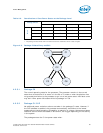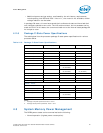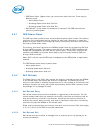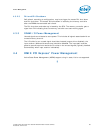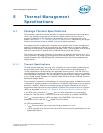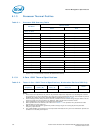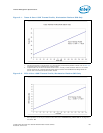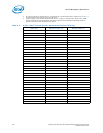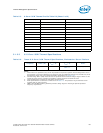
Thermal Management Specifications
102 Intel® Xeon® Processor E5-1600/E5-2600/E5-4600 Product Families
Datasheet Volume One
The temperature reported over PECI is always a negative value and represents a delta
below the onset of thermal control circuit (TCC) activation, as indicated by PROCHOT_N
(see Section 7, “Electrical Specifications”). Systems that implement fan speed control
must be designed to use this data. Systems that do not alter the fan speed need to
guarantee the case temperature meets the thermal profile specifications.
Some processor SKUs support two thermal profiles; refer to Table 5-1for a summary of
the planned SKUs and their supported thermal profiles. Both ensure adherence to Intel
reliability requirements. Thermal Profile 2U is representative of a volumetrically
unconstrained thermal solution (that is, industry enabled 2U heatsink). With single
thermal profile, it is expected that the Thermal Control Circuit (TCC) would be activated
for very brief periods of time when running the most power intensive applications.
Thermal Profile 1U is indicative of a constrained thermal environment (that is, 1U form
factor). Because of the reduced cooling capability represented by this thermal solution,
the probability of TCC activation and performance loss is increased. Additionally,
utilization of a thermal solution that does not meet Thermal Profile 1U will violate the
thermal specifications and may result in permanent damage to the processor. Refer to
the
Intel® Xeon® Processor E5-1600/E5-2600/E5-4600 Product Families Thermal/
Mechanical Design Guide for details on system thermal solution design, thermal profiles
and environmental considerations. The upper point of the thermal profile consists of the
Thermal Design Power (TDP) and the associated T
CASE
value. It should be noted that
the upper point associated with Thermal Profile 1U.
(x = TDP and y = T
CASE_MAX_B
@ TDP) represents a thermal solution design point. In
actuality the processor case temperature will not reach this value due to TCC
activation.
For Embedded Servers, Communications and storage markets Intel has plan SKU’s that
support Thermal Profiles with nominal and short-term conditions designed to meet
NEBS level 3 compliance. For these SKU’s operation at either the nominal or short-term
thermal profiles should result in virtually no TCC activation. Thermal Profiles for these
SKU’s are found in Table 5-1.
Intel recommends that complete thermal solution designs target the Thermal Design
Power (TDP). The Adaptive Thermal Monitor feature is intended to help protect the
processor in the event that an application exceeds the TDP recommendation for a
sustained time period. To ensure maximum flexibility for future requirements, systems
should be designed to the Flexible Motherboard (FMB) guidelines, even if a processor
with lower power dissipation is currently planned. The Adaptive Thermal Monitor
feature must be enabled for the processor to remain within its specifications.
5.1.2 T
CASE
and DTS Based Thermal Specifications
To simplify compliance to thermal specifications at processor run time, the processor
has added a Digital Thermal Sensor (DTS) based thermal specification. Digital Thermal
Sensor reports a relative die temperature as an offset from TCC activation
temperature. T
CASE
thermal based specifications are used for heat sink sizing and DTS
based specs are used for acoustic and fan speed optimizations. For the processor
family, firmware (for example, BMC or other platform management devices) will have
DTS based specifications for all SKUs programmed by the customer. 8-core and 6-core
SKUs may share T
CASE
thermal profiles but they will have separate T
DTS
based thermal
profiles. See Table 5-1 for the T
CASE
and DTS SKU summary.
The processor fan speed control is managed by comparing DTS thermal readings via
PECI against the processor-specific fan speed control reference point, or Tcontrol. Both
Tcontrol and DTS thermal readings are accessible via the processor PECI client. At a
one time readout only, the Fan Speed Control firmware will read the following:




